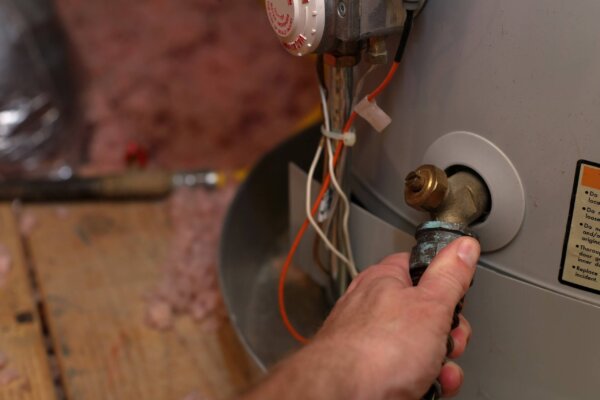8 Steps to Flushing Your Water Heater
Water heaters have a sizeable tank meant to ensure a constant water supply. However, the unit will lose its efficiency with time, especially if you fail to clean the tank often. Mineral sediment and scale may begin to build up, forming a thick coating over the heating element. This diminishes heat transfer to the water and leads to energy waste. When you continue to use the water heater in this condition, the sediment may break up and begin to flow through the pipes, causing a clog. Therefore, you should clean and flush your water heater tank after one or three years, depending on your water source and your unit’s model. However, if you haven’t cleaned the tank for years, you should have a professional handle it because the flushing process could cause leaks. Otherwise, follow the procedure below to flush your water heater.
1. Turn Off the Unit
Before flushing the tank, you need to look for the power source and turn it off to create a safe environment. If you are using an electric water heater, locate the breaker or fuse box, a small panel with a swing door attached to a wall in the garage or outside the house. Once you open up the box cover, you should see small switches, and if you can’t identify the exact one that powers your heater, shut off the main circuit breaker. If you find a tube with metallic ends after opening the panel, you have a fuse box. In this case, you need to unfasten and take out the fuse powering the water heater. If you can’t determine the exact one, pull out the handle at the top of the panel to shut off the power to the entire house.
On the other hand, if you have a gas-powered water heater, look for a red knob at the section where the gas pipe enters the unit. It has “On,” “Off” and “Pilot” settings. Turn it to the “Off” position.
2. Stop the Cold Water Supply
Turn off the inlet valve to cut the cold water supply to the tank. If the pipe has a ball valve, give it a 90-degree turn. A lever-like valve should be turned perpendicular to the line. If you leave the water flowing into the unit while flushing, it makes the process messier, and you will incur high bills.
3. Give the Water Time to Cool
Give the water in the tank ample time to cool before flushing. Handling hot water can lead to scalding, so leave the tank for one to two hours after turning off the heating element. If you intend to use the collected water for other purposes, let the tank cool overnight.
4. Open a Hot Water Faucet
Note that during the flushing process, a vacuum may form in the pipes. To avoid this, open a hot water faucet in your house and leave it running throughout the flushing process. This will also help the water drain faster.
5. Attach a Hose to the Tank
Next, determine where you want to drain the water and fit a hose to the drain cock or valve. Fix the hose firmly to prevent leaks. If you don’t have a garden hose, you can drain the water into a container, but you will have to let it cool adequately. Be careful with the type of hose and container you use for the draining task. A low-quality material may soften and leak due to the heat.
6. Turn on the Spigot and Drain
Extend the hose to a safe place where you can discharge the water. This could be an outside drain, the sewer line or the driveway. Open the water heater’s drain valve to let out the water. You can also open the pressure valve to allow the water to flow out more freely. Before opening the pressure valve, remember to put a container under it to collect the dripping water. The water may appear a bit brownish from sediment. For a tank that has too many deposits, you will need to drain it completely.
7. Flush the Tank
Put the draining water in a bucket, leave it for some minutes and observe. If the water draining out is still unclear, open up the cold water valve. This will help rinse out any sediment at the bottom of the tank. Let the water run for a few minutes. Flush until you have little or no residue coming out with the water, and then turn off the cold water supply.
8. Finish Up and Restore the Unit’s Power
Once you finish flushing, disconnect your garden hose. Use a wet/dry vacuum to suck up any sediments that could be at the opening. Shut off the drain valve. Next, turn off the hot water spigot and the pressure relief valve as well. Refill the water heater tank with clean water. Once the pressure stabilizes, slowly open the pressure relief valve to remove the excess air, and then close it. Open a hot water spigot and let it run for some time to get rid of any air remaining in the system. At this point, only cold water should come out.
Once the hot water tap begins to run at full volume, it’s safe to restore the power. Turn the gas supply back on, flip the circuit breaker or replace the fuse. Remember also to reset the thermostat to your preferred settings. Give the heater about twenty minutes, and then turn on a hot water tap. Observe how the water heater functions and test the water temperature.
Professional Water Heater Draining Services
Flushing your water heater often increases its efficiency and longevity. Whether you use hard or soft water, the unit collects a significant amount of sediment. This increases the risk of tank damage, clogs the waterline and limits the amount of water available in your tank. There are various signs that you need to flush your unit. If your tank produces some strange noises, this is an indication of sediment accumulation. When you run your water heater, the particles hit against one another, making some rumbling sounds.
Don’t ignore foul odors or a rusty color in your water. When you neglect the tank, bacteria begin to build up, and your water quality deteriorates. Have an experienced plumber clean the tank and sanitize it to eliminate the nasty smells and lower the risk of infection. Sediment also leads to corrosion, which may change the color of the water. Pay attention to changing water temperature. If your heater begins to produce colder water, it could be due to dirt accumulation at the heating element or in the pipes. In addition, flush your tank if it heats up slowly or if you notice that the hot water doesn’t last long.
If you aren’t confident flushing your water heater tank on your own, don’t hesitate to contact Crystal Blue Plumbing Heating & Air. We provide reliable plumbing, air conditioning, and heating services to the people of Loomis and the entire Sacramento area. Our company also offers whole-house fans, humidifiers, dehumidifiers, UV lights, ductless systems and indoor air quality service. Of course, we install, maintain and repair all these systems. Reach out to our reliable team today and schedule an appointment.







